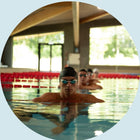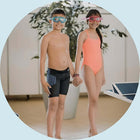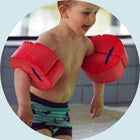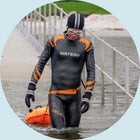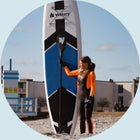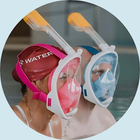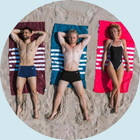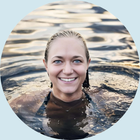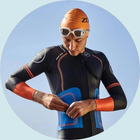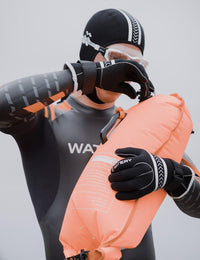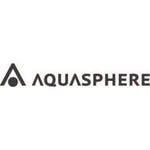When you dive into the swimming pool without a plan, it often results in just swimming back and forth a bit until you've covered the distance you had in mind. Maybe 1,000 meters – perhaps more, perhaps less.
However, this isn't a particularly effective way to make the most out of your swim training.
If you want to progress in the water, improve technically, swim faster, or just swim longer without getting completely exhausted, you need a structured swimming program.
And that’s exactly what you’ll find here: 300 complete swimming programs – free – divided into three skill levels.
I've created these so you can step into the water with a clear plan:
-
Beginner: 0 to 1,000 meters over 15 weeks
-
Intermediate: 1,000 to 2,000 meters over 16 weeks
-
Advanced: 2,000 to 4,000 meters over 16 weeks
The programs are developed based on how swim training always works best: A mix of technique, easy sessions, tougher intervals, and recovery. You’re not just told to “swim 1,000 meters" - you receive a practical plan that systematically improves your performance in the pool.
Select your level below:
-
Jump to the section "Swimming Program for Beginners"
- Jump to the section "Swimming Program for Intermediate"
- Jump to the section "Swimming Program for Experienced"
Recommended gear for all levels:
The Swim Programs
We have categorized the free swim programs into three levels: Beginner, Intermediate, and Advanced. Try to choose the program that you feel best matches your abilities.
Swimming Program for Beginners (0-1,000 meters over 15 weeks)
If you are completely new to the pool or just want to start swim training in a structured manner, then this is the program for you. Over 15 weeks, you'll be guided from short sessions of 300-400 meters up to being able to swim 1,000 meters without difficulties.
The program is structured to teach you technique step-by-step while gradually increasing the distance. You’ll get both easy sessions, small technical exercises, and short intervals to help your body get accustomed to working in the water – without being too tough at the start.
Find the free program here: Swimming Program for Beginners (0 to 1,000 meters over 15 weeks)
Preview - Week 1
Here are the first two sessions of the beginner program so you can take them directly to the pool today. You can download the entire course with 15 weeks of swim training through the button above.
Week 1 - Session 1
| Set | Content | Intensity | Rest | Meters |
|---|---|---|---|---|
| Warm-up | 50 m choice of stroke | Z1 | — | 50 |
| Technique | Balance/streamline | Z1 | — | — |
| Aerobic | 2×50 m steady pace | Z2 | 20-30 s | 100 |
| Relaxed | 50 m easy pace | Z1 | — | 50 |
| Anaerobic | 2×25 m fast | Z4 | 30-45 s | 50 |
| Cooldown | 50 m easy pace | Z1 | — | 50 |
| Total: 300 m • approx. 25 min | ||||
Week 1 - Session 2
| Set | Content | Intensity | Rest | Meters |
|---|---|---|---|---|
| Warm-up | 100 m choice of stroke | Z1 | — | 100 |
| Technique | Balance exercises | Z1 | — | — |
| Aerobic | 1×50 m steady pace | Z2 | 20-30 s | 50 |
| Relaxed | 50 m easy pace | Z1 | — | 50 |
| Anaerobic | 2×25 m fast | Z4 | 30-45 s | 50 |
| Cooldown | 50 m easy pace | Z1 | — | 50 |
| Total: 350 m • approx. 25 min | ||||
Swimming Program for Intermediate (1,000-2,000 meters over 16 weeks)
If you already have some experience in the pool and can swim 1,000 meters without difficulty but want to become stronger, faster, and add more variety to your swim training, then this is the program for you. Over 16 weeks, you will be guided from approximately 1,000 meters per session up to 2,000 meters – with a good mix of technique, easy distances, and tougher intervals.
Find the free program here: Swimming Program for Intermediate (1,000 to 2,000 meters over 16 weeks)
Preview - Week 1
Here are the two training sessions from week 1 so you can start today. You can download the entire 16-week swim training course using the button above.
Week 1 - Session 1
| Set | Content | Intensity | Rest | Meters |
|---|---|---|---|---|
| Warm-up | 200 m choice of stroke | Z1 | — | 200 |
| Technique | Drills (e.g., catch-up) | Z1 | — | 200 |
| Aerobic | 6×100 m steady pace | Z2-Z3 | 15-25 s | 600 |
| Relaxed | 50 m easy pace | Z1 | — | 50 |
| Anaerobic | 8×50 m short, fast | Z4-Z5 | 30-45 s | 400 |
| Cooldown | 50 m easy pace | Z1 | — | 50 |
| Total: 1,500 m • approx. 45 min | ||||
Week 1 - Session 2
| Set | Content | Intensity | Rest | Meters |
|---|---|---|---|---|
| Warm-up | 200 m choice of stroke | Z1 | — | 200 |
| Technique | Drills (e.g., 6-3-6) | Z1 | — | 200 |
| Aerobic | 6×100 m steady pace | Z2-Z3 | 15-25 s | 600 |
| Relaxed | 50 m easy pace | Z1 | — | 50 |
| Anaerobic | 4×50 m short, fast | Z4-Z5 | 30-45 s | 200 |
| Cooldown | 50 m easy pace | Z1 | — | 50 |
| Total: 1,300 m • approx. 45 min | ||||
Swimming Program for Advanced (2,000-4,000 meters over 16 weeks)
If you already have considerable experience in the pool and can swim over 2,000 meters without major issues, then this program is for you. Here you'll tackle longer distances and tougher intervals, pushing technique, speed, and endurance. Over 16 weeks, you'll build up to solid sessions of 3,000-4,000 meters – perfect for those seeking serious swim training, whether the goal is competition, triathlon, or just becoming sharper in the water.
Find the free program here: Swimming Program for Advanced (2,000 to 4,000 meters over 16 weeks)
Preview - Week 1
Here are the first three sessions from week 1, showing how an advanced course is structured. You can download the complete 16-week swim training program above.
Week 1 - Session 1
| Set | Content | Intensity | Rest | Meters |
|---|---|---|---|---|
| Warm-up | 300 m mixed strokes | Z1 | — | 300 |
| Technique | 200 m drills | Z1 | — | 200 |
| Aerobic | 10×100 m steady pace | Z2-Z3 | 10-20 s | 1,000 |
| Relaxed | 100 m easy pace | Z1 | — | 100 |
| Anaerobic | 6×50 m hard | Z4 | 30-60 s | 300 |
| Cooldown | 100 m easy pace | Z1 | — | 100 |
| Total: 2,000 m • approx. 55 min | ||||
Week 1 - Session 2
| Set | Content | Intensity | Rest | Meters |
|---|---|---|---|---|
| Warm-up | 300 m mixed strokes | Z1 | — | 300 |
| Technique | 200 m drills | Z1 | — | 200 |
| Aerobic | 9×100 m steady pace | Z2-Z3 | 10-20 s | 900 |
| Relaxed | 100 m easy pace | Z1 | — | 100 |
| Anaerobic | 6×50 m hard | Z4 | 30-60 s | 300 |
| Cooldown | 100 m easy pace | Z1 | — | 100 |
| Total: 1,900 m • approx. 65 min | ||||
Week 1 - Session 3
| Set | Content | Intensity | Rest | Meters |
|---|---|---|---|---|
| Warm-up | 300 m mixed strokes | Z1 | — | 300 |
| Technique | 300 m drills | Z1 | — | 300 |
| Aerobic | 9×100 m steady pace | Z2-Z3 | 10-20 s | 900 |
| Relaxed | 100 m easy pace | Z1 | — | 100 |
| Anaerobic | 4×50 m hard | Z4 | 30-60 s | 200 |
| Cooldown | 100 m easy pace | Z1 | — | 100 |
| Total: 1,900 m • approx. 60 min | ||||
The discount code can be used by all new customers on all products on the website, including the products recommended here in the article. What are you waiting for? Get more out of your time in and on the water!
GET A DISCOUNT CODE WITH 10% OFF
Who’s Behind These Swim Programs?
These programs are developed by me, Daniel Johannesen – a former elite swimmer for 10 years and now the founder of Watery.dk. I have personally swum through all three levels: from the first short swims as a beginner, to numerous weekly sessions as a competitive swimmer, and now as a recreational swimmer.
These programs are designed to be easy to follow, easy to print, and ready to take directly to the pool. And most importantly: they are a guide – always listen to your body and adjust if needed.
If you have questions, are curious about something, or have suggestions for improvements, feel free to write to us at support@watery.dk or call us on 71 74 71 94. We’re always ready to help you advance your swim training.
Enjoy your training!
How to Use the Programs
Before you jump in the water, it's a good idea to understand the small details these programs are built on. They make the difference between just “swimming meters” and actually benefiting from the training.
Intensity Zones (Z1-Z5) All the programs are divided into zones. This tells you how hard you should swim.
| Zone | Description | How does it feel? |
|---|---|---|
| Z1 - Easy | Warm-up, technique, and cooldown | Relaxed pace – you can talk without getting out of breath |
| Z2 - Aerobic | Conditioning training with longer sets | You’re working, getting warm and slightly out of breath – but can maintain the pace for a long time |
| Z3 - Moderately hard | More demanding sets | You need to concentrate to maintain the pace. Hard to talk, but you can still swim steadily |
| Z4 - Anaerobic | Short, hard sets with longer breaks | You feel the burn in your muscles and are pushed hard |
| Z5 - Very hard | Sprint and maximum effort | 100% effort over short distances – mostly used by experienced swimmers |
👉 As a beginner, don't be intimidated by Z4 and Z5 – they appear only in small doses, and you can always adjust down if it feels too tough.
Breaks and Pace
When it says for example “rest 20–30 seconds,” it means that after an interval, you should keep an eye on the clock (the large one on the wall in the swimming pool) and give yourself that break before starting the next lap.
A “steady pace” (typically Z2-Z3) means you should swim with the same rhythm throughout – don't start fast and burn out halfway.
Basic Principles of the Swim Programs
Each session is built in a fixed sequence. This makes it easy to keep track of pace, breaks, and purpose – ensuring that you improve both technically and physically.
Warm-up
Prepare your body with easy meters and various strokes. The focus is on rhythm, breathing, and finding a good grip on the water.
- Typical duration: 5-10 min
- Intensity: Z1 (easy)
- Tip: Switch between backstroke, breaststroke, and freestyle to use your whole body
Technique
This is where you refine movements. Focus on one detail at a time (e.g., streamline, catch-up, or breathing) and extend rest periods a little.
- Set lengths: 25-50 m
- Intensity: Z1 (slow, controlled)
- Tip: Think “quality over quantity” – better to go slow and correct
Aerobic
Conditioning training at a steady pace. You get warm and slightly out of breath but can maintain the pace over longer sets.
- Set lengths: typically 50-200 m repetitions
- Intensity: Z2-Z3
- Rest: 10-30 seconds per repetition
Relaxed
Active rest between sets. Very slow pace to shake out lactic acid and lower your heart rate.
- Typically 50-200 m
- Intensity: Z1
- Tip: Think long, smooth strokes and relaxed shoulders
Anaerobic
Short, hard sets where you work near max and feel the burn. Used in small doses to increase speed and capacity.
- Set lengths: 25-50 m (short intervals)
- Intensity: Z4-Z5
- Rest: 30-60 seconds
Cooldown
Always finish at an easy pace to start recovery. Slow your breathing and find a calm rhythm again.
- Typical duration: 2-6 min
- Intensity: Z1 (very easy)
- Tip: Consider using backstroke to loosen shoulders
|
Week X of 16 |
Program: 1 of 3 this week |
Remarks |
Distance (meters) / approx. time (min.) |
|
Warm-up |
It's beneficial to swim/move different parts of the body here. This can be done by swimming different strokes. Typically, you should aim for the warm-up to take 5 to 10 minutes. This warm-up should prepare you to swim technically well and at the right speed in the following sets. |
The warm-up is swum easily without necessarily getting out of breath. |
Here you indicate how far you have swum in the different sets measured in meters. The warm-up takes about 5 to 10 minutes. |
|
Technique |
Technique training is about improving your existing swimming. For this to succeed, a surplus in the body and mind is necessary, as you need to change a habit you've had. You need to learn new and more effective movements in swimming instead of poor/harmful/less effective movements. Remember to focus on only one detail at a time. |
This section is usually swum easily over short distances of 25 and 50 meters, with long breaks between each repetition. |
|
|
Aerobic |
Here you pick up the pace a bit, where you become out of breath while swimming at the same speed over longer distances. But aerobic swimming is about physical training of the heart, lungs, circulation, and muscles, achieved when swimming relatively long sets with short rest between each segment at a steady pace. |
Essentially, pulse and fatigue should be moderately high when swimming over a longer period, maybe 20 to 40 minutes. This is the part that takes the most time. |
|
|
Relaxed |
After completing an aerobic or anaerobic set, it is sensible to do some active rest, where you shake out all the acid from the body/go down a gear again. Here it is far more effective for recovery to swim very easily than to rest passively at the edge. So swim very quietly! |
Swum leisurely with as low a pulse as possible. Preferably just 100 to 200 meters. |
|
|
Anaerobic |
Here you speed up, which is also called “lactic acid swim training.” The most important thing is that the swimming feels like a hard load, not maximum, but it should be noticeable. Therefore, the speed must also automatically be very high. |
Swum hard to very hard. Typically a set of 10 to 20 minutes. |
|
|
Cooldown |
When the hard swimming is over, you should swim 2-6 minutes of easy swimming to start recovery, so you will feel fresh sooner for the next swim training. |
Swum very easily, like relaxed. |
To sum it all up, most swim programs are structured with a little warm-up, a bit of technique swimming, followed by a longer set with moderate-intensity subdivision, and finally ending with faster, shorter sets with longer breaks.
The experience you will be left with when building the training from lighter to harder is also very beneficial for one's mindset during the swim training.
Tips for Your Swim Training with the Programs

The swim programs you find here are not personally tailored – they are created as inspiration to help you add structure to your swim training.
Your success doesn’t depend on strictly following every single meter. The most important thing is to listen to your body. If you notice the start of an illness, a higher resting heart rate than normal, or unusual soreness in your arms and legs, these are signs that you need more recovery before you hit the water again.
If you do the opposite and train anyway, you risk wearing your body down instead of building it up.
A good rule of thumb is:
-
It’s okay for it to feel hard when you swim.
-
But it should never hurt.
Especially as a beginner, it can be difficult to distinguish between “normal training soreness” and real pain. If you’re unsure, always choose the safe side and skip the session. It’s never the one session that determines whether you reach your goal – but it can be the one session that prevents you from reaching it.
But fundamentally, the above programs are designed to account for this, so the progression happens naturally so that most can keep up. As long as you follow the plan that suits your level before you started the programs, there shouldn’t be major problems.
Alternative Training to Swimming
There will be days when it just doesn’t make sense to hit the water – maybe you’re slightly ill, maybe the pool is closed, or maybe you just need some variety. And that’s perfectly fine.
In these situations, you can choose another form of exercise that still maintains conditioning without overly burdening your body. Cycling is an obvious alternative, but running, rowing, or a visit to the gym also works very well.
For extra benefit, you can supplement with core and stability training. A strong core makes it much easier to maintain a good water position when you swim.
Alternative training can also be used on your rest days if you want to move your body without getting in the water.
The discount code can be used by all new customers on all products on the website, including the products recommended here in the article. What are you waiting for? Get more out of your time in and on the water!
GET A DISCOUNT CODE WITH 10% OFF
Missed Swim Training? Here’s Why You Shouldn’t Catch Up
Many make the classic mistake: They miss a session – and then try to squeeze it in the next day or on top of the next session. This is a really bad idea.
When you skip a swim session, it’s just gone. And that’s perfectly okay. The programs are built so that you can continue without issues, even if you miss a session now and then.
If you’ve been ill and missed an entire week, start back slowly the next week. Perhaps only swim half the distance in the first sessions – then gradually ramp up to the full program again.
Forcing your body to “make up the lost time” typically results in the opposite of what you hope for: overstrain, injuries, and extended breaks.
Many make the mistake that when they naturally miss a session now and then, they try to squeeze it back in right away. Don’t make that mistake. Missed swim sessions should not and should not be made up at another time. If you miss a whole week of training due to sickness, take some time and start gradually again the following week, maybe only completing half the meters at first, before fully gearing up again.
How Often Should You Swim? Planning Your Rest Days
When you train swimming, it’s actually the rest between your sessions that makes you better – not the time spent in the water. During training, muscles and tendons break down, and only when you rest does your body build back stronger.
Thus, you should always have at least one rest day between your swim sessions. This gives your body time to recover, preventing overtraining and maximizing the benefits of each session.
As you become more experienced and your body gets accustomed to the load, you can gradually increase the frequency. Many advanced swimmers can handle 3–4 sessions in a row, but for beginners, this would only elevate the risk of injuries and fatigue.
A good rule of thumb: Better to swim three quality sessions a week with energy to spare than five mediocre ones where you push a tired body in the pool.

Can You Swap Your Swim Programs Around in the Week?
The short answer: Yes, of course – within the same week, you can certainly swap the individual sessions around.
Your swimming program needs to fit into your life – not the other way around. If you have a busy week or a day where the energy is just not there, it’s perfectly fine to switch the sequence of sessions within the same week.
The most important thing is to complete the planned sessions with approximately the same distribution of intensity and distance that the program suggests. Whether you do the technique session on Tuesday and the tougher interval session on Thursday or vice versa doesn’t make a big difference.
As long as you maintain rest between sessions and listen to your body, you will still gain full benefit from the swim training.
You are now ready to head to the water with a focused swim program in hand.
Whether you are a beginner, intermediate, or advanced, it’s about starting at the right level, sticking to the rest periods, and listening to your body along the way.
The programs provide a clear direction and variety in training – but it's you who fills them with life, motivation, and good kilometers in the pool.
So, my best advice is: Print the program, bring it to the pool, and try it out on your next swim. You’ll be surprised at how much more enjoyable swim training feels with a clear plan.
Enjoy – and remember, you can always reach out to us if you have questions or need advice.
Former elite swimmer and founder of Watery.dk
Daniel has over 10 years of experience as a competitive swimmer at the elite level and has worked professionally with swimming and training equipment for more than 8 years. He founded Watery.dk to combine his passion for swimming with expert knowledge, so both beginners and experienced swimmers can get the most out of their training.
Download the Free Swim Programs Here
1. Free Swimming Program for Beginners (0 to 1,000 meters over 15 weeks)
2. Free Swimming Program for Intermediate Swimmers (1,000 to 2,000 meters over 16 weeks)
3. Free Swimming Program for Advanced Swimmers (2,000 to 4,000 meters over 16 weeks)
